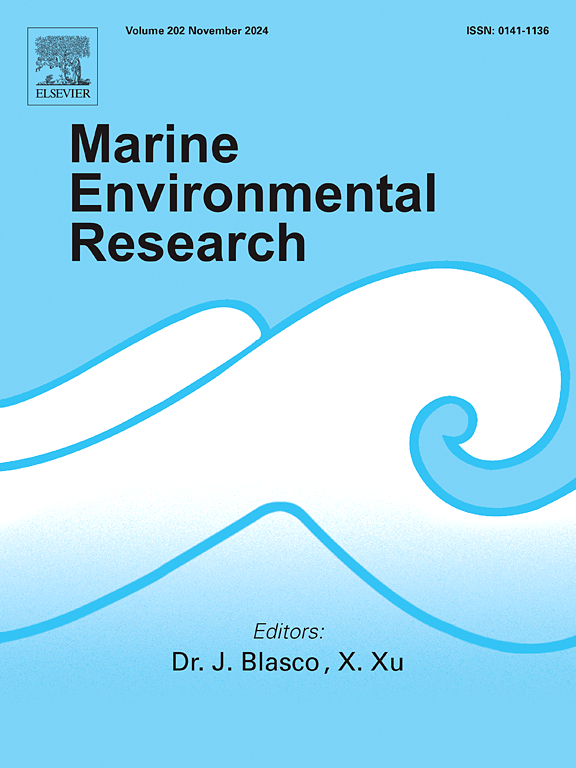Metabolomic and physiological analyses of two picochlorophytes from distinct oceanic latitudes under future ocean acidification and warming
IF 3
3区 环境科学与生态学
Q2 ENVIRONMENTAL SCIENCES
引用次数: 0
Abstract
Phytoplankton are cosmopolitan marine photosynthetic organisms that are vital to biogeochemical cycles and marine ecosystems. The current rise in atmospheric CO2 and surface ocean temperatures are poised to disrupt the ecological niches of phytoplankton. Picochlorophytes, a broad taxon of small green eukaryotic phytoplankton, have been shown to perform well under future rising oceanic CO2 and temperature scenarios. This study investigates the acclimation responses of cosmopolitan picochlorophytes from the Chlorella-lineage under high CO2 (1000 p.p.m.) and a rise of 4 °C (8 °C – polar picochlorophyte; 32 °C, tropical picochlorophyte). In order to determine how the future ocean warming and acidification might affect picochlorophytes, a polar strain of Chlorella and a tropical Parachlorella were selected, and their physiology and GCMS-based metabolomics were investigated. Growth rate and cellular dimensions (diameter, volume, and surface area) of Chlorella significantly increased in all environmental future scenarios compared to Parachlorella. Photosynthetic parameters of the picochlorophytes studied showed acclimation, with high temperature and high CO2 triggering the adaptation of Fv/Fm, NPQmax, and Ek of Chlorella and Parachlorella, respectively. High CO2 induced the most changes in the Chlorella metabolome, altering the levels of metabolites related to amino acids and their derivatives, glutathione production, carbohydrates, and photochemical quenching. Combined high CO2/temperature altered Parachlorella's metabolome, though with a small number of biomarkers detected. This study provided evidence to support the hypothesis that picochlorophytes could thrive in a more acidified and warmer ocean.

未来海洋酸化和变暖条件下不同海洋纬度两种小绿藻的代谢组学和生理分析
浮游植物是世界性的海洋光合生物,对生物地球化学循环和海洋生态系统至关重要。目前大气中二氧化碳和海洋表面温度的上升将破坏浮游植物的生态位。小绿藻是一种广泛的小型绿色真核浮游植物,已被证明在未来海洋二氧化碳和温度上升的情况下表现良好。本文研究了小球藻系世界性小绿藻在高CO2 (1000 p.p.m.)和4°C(8°C -极地小绿藻)升高条件下的驯化响应;32°C,热带小绿藻)。为了确定未来海洋变暖和酸化对小绿藻的影响,选择了一个极地菌株小球藻和一个热带副球藻,对它们的生理和基于gcms的代谢组学进行了研究。与副球藻相比,小球藻的生长速度和细胞尺寸(直径、体积和表面积)在所有环境情景下都显著增加。研究的小绿藻光合参数表现为驯化,高温和高CO2分别触发小球藻和副球藻的Fv/Fm、NPQmax和Ek的适应。高CO2诱导的小球藻代谢组变化最大,改变了与氨基酸及其衍生物、谷胱甘肽生产、碳水化合物和光化学猝灭相关的代谢物水平。尽管检测到少量生物标志物,但高CO2/高温联合改变了副伞菌的代谢组。这项研究提供了证据,支持小绿藻可以在更酸化和更温暖的海洋中茁壮成长的假设。
本文章由计算机程序翻译,如有差异,请以英文原文为准。
求助全文
约1分钟内获得全文
求助全文
来源期刊

Marine environmental research
环境科学-毒理学
CiteScore
5.90
自引率
3.00%
发文量
217
审稿时长
46 days
期刊介绍:
Marine Environmental Research publishes original research papers on chemical, physical, and biological interactions in the oceans and coastal waters. The journal serves as a forum for new information on biology, chemistry, and toxicology and syntheses that advance understanding of marine environmental processes.
Submission of multidisciplinary studies is encouraged. Studies that utilize experimental approaches to clarify the roles of anthropogenic and natural causes of changes in marine ecosystems are especially welcome, as are those studies that represent new developments of a theoretical or conceptual aspect of marine science. All papers published in this journal are reviewed by qualified peers prior to acceptance and publication. Examples of topics considered to be appropriate for the journal include, but are not limited to, the following:
– The extent, persistence, and consequences of change and the recovery from such change in natural marine systems
– The biochemical, physiological, and ecological consequences of contaminants to marine organisms and ecosystems
– The biogeochemistry of naturally occurring and anthropogenic substances
– Models that describe and predict the above processes
– Monitoring studies, to the extent that their results provide new information on functional processes
– Methodological papers describing improved quantitative techniques for the marine sciences.
 求助内容:
求助内容: 应助结果提醒方式:
应助结果提醒方式:


